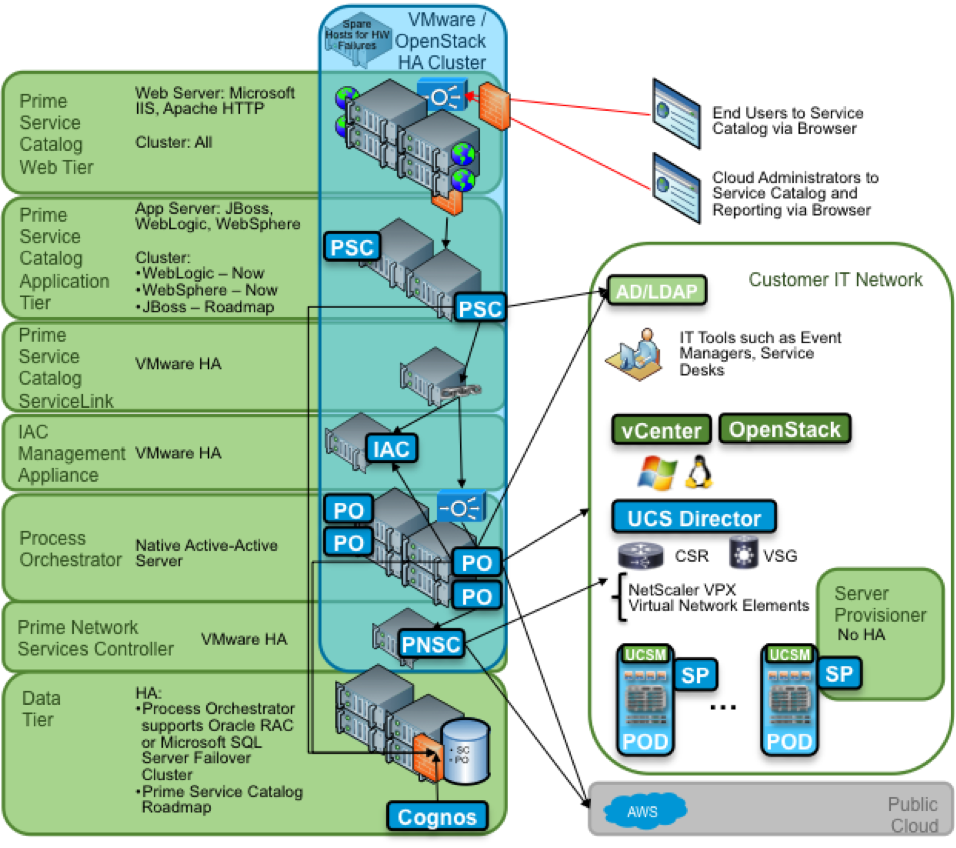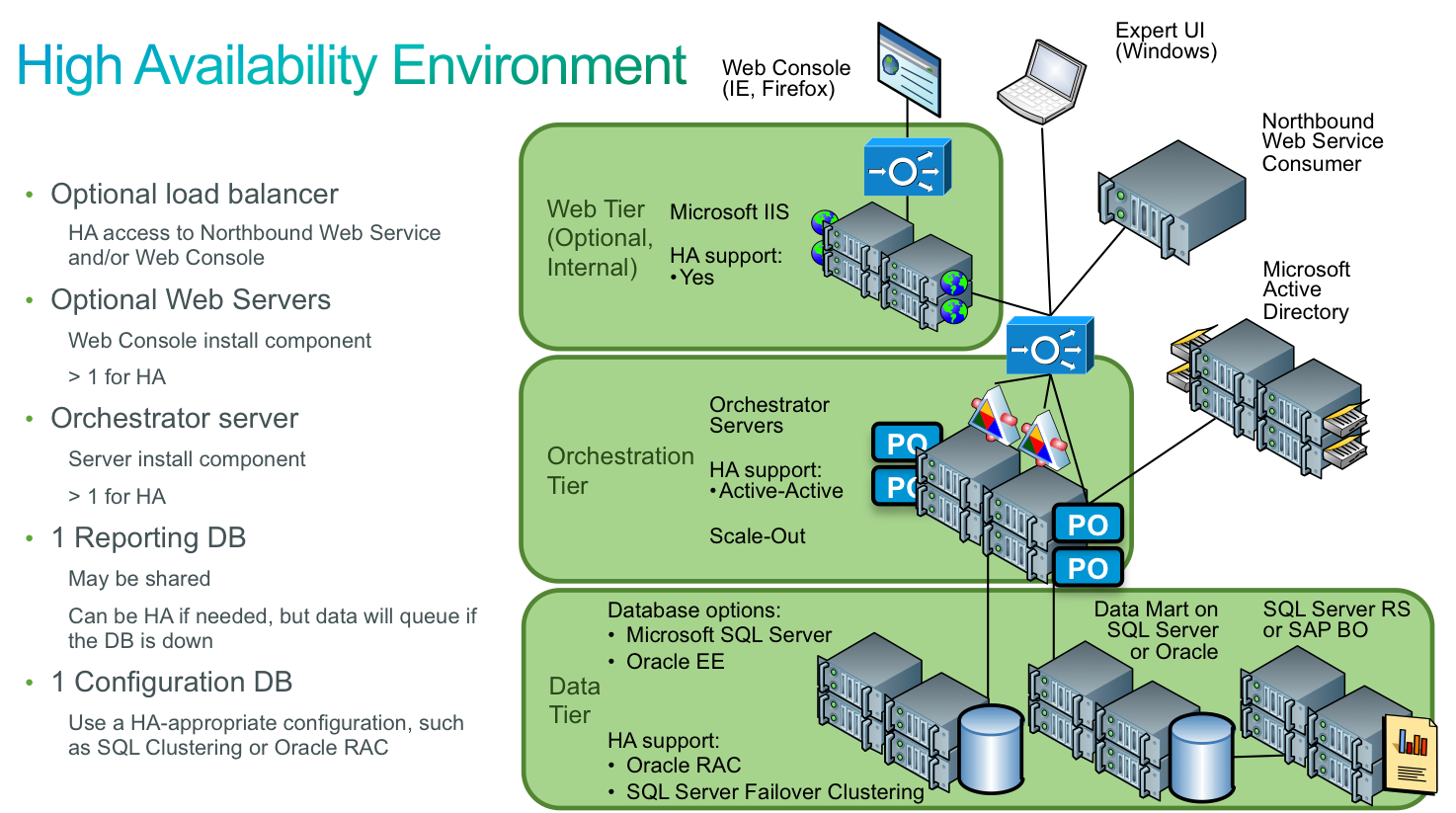- Cisco Community
- Technology and Support
- Data Center and Cloud
- Intelligent Automation
- Re: CPO High Availability
- Subscribe to RSS Feed
- Mark Topic as New
- Mark Topic as Read
- Float this Topic for Current User
- Bookmark
- Subscribe
- Mute
- Printer Friendly Page
- Mark as New
- Bookmark
- Subscribe
- Mute
- Subscribe to RSS Feed
- Permalink
- Report Inappropriate Content
03-15-2013 01:15 AM
Hi,
Was wondering what is on the roadmap to make CPO into a HA solution, as CIAC is being deployed in environments where no down time is critical the entire CIAC solution needs to be HA. For that matter does NSM and CSP have HA capabilities?
Can someone provide some documentation on the road map for CPO?
thanks
Solved! Go to Solution.
- Labels:
-
Cisco Process Orchestrator
Accepted Solutions
- Mark as New
- Bookmark
- Subscribe
- Mute
- Subscribe to RSS Feed
- Permalink
- Report Inappropriate Content
03-07-2014 06:15 AM
- Mark as New
- Bookmark
- Subscribe
- Mute
- Subscribe to RSS Feed
- Permalink
- Report Inappropriate Content
03-15-2013 05:27 AM
HA is a cornerstone feature of our Cisco Process Orchestrator 3.0 release. It will be achieved through an active-active server, which will also support scale-out scenarios for performance and scalability. The solution can scale beyond 2 to N servers in an HA environment which share load. PO 3.0 is planned for availability in fiscal Q1 of 2014.
NSM is not HA other than the VMware HA configuration for the controller as described in the HA IAC paper which is available through your Cisco representative under NDA.
Server Provisioner is also not HA and this is not in its immediate roadmap.
- Mark as New
- Bookmark
- Subscribe
- Mute
- Subscribe to RSS Feed
- Permalink
- Report Inappropriate Content
03-07-2014 05:45 AM
Has there been any documentation around setting up an HA environment for CPO as well as CPSC?
- Mark as New
- Bookmark
- Subscribe
- Mute
- Subscribe to RSS Feed
- Permalink
- Report Inappropriate Content
03-07-2014 05:49 AM
If you install CPO 3.0 , it is now HA. You install nodes and build it out in the standard installer. (so nothing hard) This is detailed in the updated install guide I believe.
Server Provisioner is still non-HA.
There is information in the CPSC guides on how to make it HA, but I believe that's more the application servers(jboss, websphere) than the actual CPSC code? Not 100% sure there but I think it's in the guides.
I'm not sure of any official white paper/doc (yet) on setting up the full CIAC stack in HA. (i'm sure there will be)
--Shaun Roberts
shaurobe@cisco.com
CIAC Adoption Pilot Engineering Lead
Principal Engineer, CX
shaurobe@cisco.com
- Mark as New
- Bookmark
- Subscribe
- Mute
- Subscribe to RSS Feed
- Permalink
- Report Inappropriate Content
03-09-2014 08:53 PM
Thanks everyone for your messages.
I believe the CPO HA Setup is straight forward as it is included in the Install guides.
For CPSC, are there any pointers to ensure we are installing the application server cluster (maybe websphere or weblogic) in the manner it is expected to be installed.
Regards,
Mohammed
- Mark as New
- Bookmark
- Subscribe
- Mute
- Subscribe to RSS Feed
- Permalink
- Report Inappropriate Content
03-07-2014 06:13 AM
The Prime Service Catalog web tier is clusterable using standard mechanisms of the chosen web server. These include a load balancer in front of web server instances. Within the web tier, it is recommended to enable cache control on the relatively static UI objects. Distributed web servers with cache control augments performance and greatly alleviates network latency issues.
The Prime Service Catalog application tier runs on one of the following application servers:
- WebSphere
- WebLogic
- JBoss
The application tier can be clustered using native WebLogic or WebSphere Application Server clustering. Prime Service Catalog does not presently support JBoss clustering though this is planned in our near term roadmap. Virtual machine migration to an alternate host, such as VMware HA, is recommended for ensuring availability on JBoss, effectively ensuring uptime in the case of a host failure. Note that services already delivered by the cloud platform are not affected by an outage at this level; only new service lifecycle requests are affected. One can also address availability on JBoss platform through cold-standby. Automatic rollover to a cold-standby instance in case of a fault can be achieved through advanced services.
Prime Service Catalog uses a component called ServiceLink to manage requests to Process Orchestrator. ServiceLink can take advantage of virtual machine migration to an alternate host, such as VMware HA, to fail over to a new host should there be any problems with its host.
- Mark as New
- Bookmark
- Subscribe
- Mute
- Subscribe to RSS Feed
- Permalink
- Report Inappropriate Content
03-07-2014 06:15 AM
The following picture depicts a production deployment of IAC:

- Mark as New
- Bookmark
- Subscribe
- Mute
- Subscribe to RSS Feed
- Permalink
- Report Inappropriate Content
03-07-2014 06:10 AM
A Process Orchestrator environment is made up of one or more active-active servers. Process Orchestrator active-active servers provide a highly available and scalable solution which is to virtually eliminates down time due to hardware or application failures. If one server fails, useful work can continue on other servers. All servers in the environment share the workload, which increases scalability and performance. The more servers available in the system, the less work each of them must perform. A Process Orchestrator environment is available during routine maintenance, such as rebooting the operating system, applying OS security patches, and performing minor upgrades, even to the Process Orchestrator itself.
The following figure illustrates the recommended Process Orchestrator high availability environment within Cisco IAC:

The Process Orchestrator environment consists of:
- A load balancer in front of the northbound web service and/or web servers.
- Optional: Multiple web servers. The Process Orchestrator web console is an optional element within IAC, and hence may be omitted or may not require high availability. Should the use case require the web console, the web servers can be clustered behind the load balancer
- Multiple Process Orchestrator servers
- A configuration database. The configuration database is specific to one environment, and therefore requires a high availability-appropriate solution.
- A reporting database. One can turn off reporting if desired. The environment requires a reporting database to enable reporting features. The reporting database can span environments and therefore can be thought of as external to the environment.
A complete discussion of Process Orchesrator availability and resiliency concerns can be found in the “Managing High Availability and Resiliency” chapter in the Cisco Process Orchestrator User’s Guide available with the Cisco Process Orchestrator product documentation on cisco.com[1]. For information about installing a highly available environment, see the Cisco Process Orchestrator Installation Guide.
Discover and save your favorite ideas. Come back to expert answers, step-by-step guides, recent topics, and more.
New here? Get started with these tips. How to use Community New member guide


